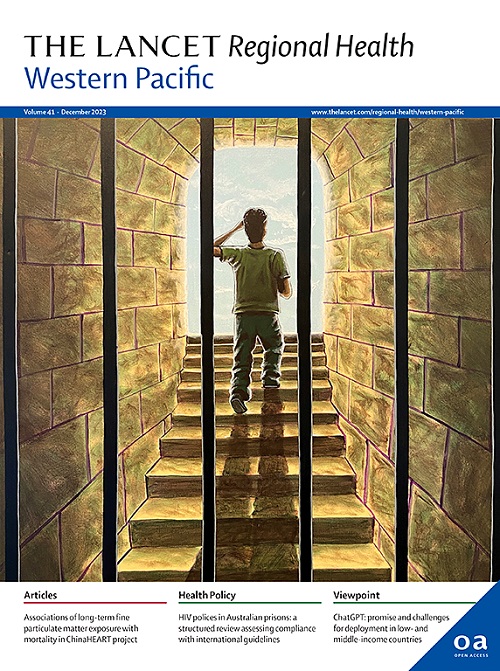Secular trends in physical fitness and cardiovascular risks among Chinese college students: an analysis of five successive national surveys between 2000 and 2019
IF 7.6
1区 医学
Q1 HEALTH CARE SCIENCES & SERVICES
引用次数: 0
Abstract
Background
With increasing concerns about early-onset cardiovascular diseases, it is essential to understand the distribution of cardiovascular health among young adults. This study aimed to characterize trends in physical fitness and the prevalence of overweight/obesity (OWOB), elevated blood pressure (EBP), and their comorbidity among Chinese college students from 2000 to 2019 and to analyze the changes in their associations and subgroup differences.
Methods
Data were extracted from five cycles of the Chinese National Survey on Students' Constitution and Health (2000–2019), including 241,710 college students aged 19–22. Physical fitness indicator (PFI) was computed using standardized z-scores of forced vital capacity, sit-and-reach, 50-m dash, standing long jump, muscle strength, and endurance running. OWOB was defined as a body mass index ≥25 kg/m2, and EBP as systolic blood pressure ≥140 mmHg and/or diastolic blood pressure ≥90 mmHg. Comorbidity was defined as the co-occurrence of OWOB and EBP. Mixed-effects logistic regression was used to analyze associations, and generalized linear mixed-effects models were applied to examine dose-response relationships.
Findings
The median of college students' PFI deteriorated continuously from −0.16 in 2000 to −1.99 in 2019, with boys experiencing a faster decline than girls. The prevalence of OWOB, EBP, and comorbidity increased significantly from 3.7%, 2.2%, and 0.3% in 2000 to 14.0%, 5.2%, and 1.8% in 2019, respectively, with boys exhibiting higher prevalence than girls. Decreasing PFI levels were significantly associated with the increasing prevalence of OWOB, EBP, and comorbidity, and such associations were strongest in 2019. L-shaped curves were observed for the relationships between PFI and the prevalence of OWOB, EBP, and comorbidity, with stronger associations in boys. Provincial population attributable fraction showed that when improving the PFI levels from low to middle-low or above, college students in Guizhou, Sichuan, and Yunnan provinces exhibited the most reductions in OWOB, EBP, and comorbidity.
Interpretation
Physical fitness among Chinese college students has significantly declined over the past two decades, accompanied by marked increases in the burden of cardiovascular risks. There is an urgent need to increase the focus on college students’ health and establish a college-based physical examination system to assess their long-term cardiovascular function.
Funding
The present study was funded by National Key R&D Program of China (Grant No. 2024YFC2707901 to Yi Song), National Natural Science Foundation of China (Grant No. 82273654 to Yi Song), and Beijing Office for Education Sciences Planning (Grant No. BBAA22027 to Yi Song).
中国大学生体质和心血管风险的长期趋势:对2000年至2019年连续五次全国调查的分析
背景随着人们对早发性心血管疾病的关注日益增加,了解年轻人心血管健康的分布是至关重要的。本研究旨在描述2000年至2019年中国大学生身体健康、超重/肥胖(OWOB)、血压升高(EBP)患病率及其合并症的趋势,并分析它们之间的关联变化和亚组差异。方法数据提取自2000-2019年全国大学生体质与健康调查的5个周期,共241710名19-22岁的大学生。体质指标(Physical fitness indicator, PFI)采用强制肺活量、坐伸、50米短跑、立定跳远、肌力和耐力跑的标准化z分数计算。OWOB定义为体重指数≥25 kg/m2, EBP定义为收缩压≥140 mmHg和/或舒张压≥90 mmHg。合并症定义为OWOB和EBP同时出现。混合效应逻辑回归用于分析关联,广义线性混合效应模型用于检验剂量-反应关系。发现大学生PFI中位数从2000年的- 0.16持续恶化至2019年的- 1.99,其中男生下降速度快于女生。OWOB、EBP和合并症的患病率分别从2000年的3.7%、2.2%和0.3%显著上升至2019年的14.0%、5.2%和1.8%,男孩的患病率高于女孩。PFI水平的下降与OWOB、EBP和合并症患病率的增加显著相关,这种关联在2019年最为明显。PFI与OWOB、EBP患病率及合并症的关系呈l型曲线,其中男孩的相关性更强。省级人群归因分数显示,当PFI水平从低到中低或更高时,贵州、四川和云南三省的大学生OWOB、EBP和合并症的降低幅度最大。在过去的二十年里,中国大学生的身体健康水平明显下降,同时心血管疾病的风险负担也明显增加。迫切需要加大对大学生健康的关注,建立以高校为基础的健康体检体系,评估大学生的长期心血管功能。基金资助:国家重点科技发展计划项目(资助号:2024YFC2707901),国家自然科学基金项目(资助号:82273654),北京市教育科学规划办公室(资助号:82273654)。BBAA22027致易松)。
本文章由计算机程序翻译,如有差异,请以英文原文为准。
求助全文
约1分钟内获得全文
求助全文
来源期刊

The Lancet Regional Health: Western Pacific
Medicine-Pediatrics, Perinatology and Child Health
CiteScore
8.80
自引率
2.80%
发文量
305
审稿时长
11 weeks
期刊介绍:
The Lancet Regional Health – Western Pacific, a gold open access journal, is an integral part of The Lancet's global initiative advocating for healthcare quality and access worldwide. It aims to advance clinical practice and health policy in the Western Pacific region, contributing to enhanced health outcomes. The journal publishes high-quality original research shedding light on clinical practice and health policy in the region. It also includes reviews, commentaries, and opinion pieces covering diverse regional health topics, such as infectious diseases, non-communicable diseases, child and adolescent health, maternal and reproductive health, aging health, mental health, the health workforce and systems, and health policy.
 求助内容:
求助内容: 应助结果提醒方式:
应助结果提醒方式:


